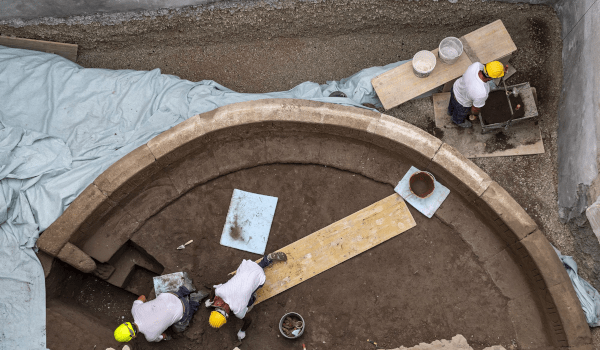POMPEII, UNEXPECTED DISCOVERY SHEDS LIGHT ON THE HISTORY OF SPAIN
A TOMB PROVIDES FASCINATING EVIDENCE ABOUT THE NETWORK OF POWER DURING THE AGE OF THE EMPEROR AUGUSTUS
A brilliant military career, followed by a comfortable retirement in the Campanian town of Pompeii, renowned for the beauty of the landscape and views of the Bay of Naples, which attracted such prestigious figures as Cicero and Agrippa. This is what emerges from the inscription on a tomb found during work to construct a cavity wall to damp-proof the basement rooms of the building of San Paolino, the new premises of the library of the Archaeological Park of Pompeii. The discovery was announced today in the E-Journal of the excavations of Pompei, the online journal that provides news in real time about the latest discoveries and research from the archaeological site. The reading and interpretation of the inscription was carried out by Maria Chiara Scappaticcio, Professor of Latin Language and Literature at the Federico II University of Naples and Alberto Dalla Rosa, Professor of Roman History at Bordeaux Montaigne University.
The excavation work, designed to create a cavity wall, had scarcely touched the two edges of the tomb, which is semicircular in shape and belongs to a type that is well-known at Pompeii: the “schola tombs” which consist of a semi-circular tuff bench decorated on the edges with lion’s paws.
This led senior staff at the Park to agree to the enlargement of the excavation and the musealisation, near the new library, of a distinctive funerary monument which can be dated to the reign of the emperor Augustus (27 BC – AD 14). The inscription on the back of the bench revealed the name of the deceased and provided several surprises for archaeologists and scholars:
N(umerio) AGRESTINO N(umerii) F(ilio) EQUITIO PULCHRO TRIB(uno) MIL(itum) PRAEF(ecto) AUTRYGON(um) PRAEF(ecto) FABR(um) II D(uum) V(iro) I(ure) D(icundo) ITER(um) LOCUS
The inscription continues in smaller letters placed below in the centre of the back of the bench:
SEPULTURAE DATUS D(ecreto) D(ecurionum)
“To Numerius Agrestinus, son of Numerius, Equitius Pulcher, a military tribune, prefect of the Autrigones, prefect of the military engineering corps, Duumvir for jurisdiction (the most important magistrate in the city of Pompeii) on two occasions, the burial place (was) decided by a decree of the city council.”
The first surprise lies in the fact that the same person is known from another funerary inscription in the necropolis of Porta Nocera, where his wife, Veia Barchilla, had a cylindrical monument built for herself and her husband. The council of the decurions subsequently decreed that Numerius Agrestinus should be honoured with a monument on public soil.
The second surprising element regards the post of “praefectus Autrygonum”. The Autorigones were a tribe from the northern regions of the Iberian peninsula, where Augustus was involved, from 29 to 19 BC, in the “Cantabrian Wars” with the aim of completing the occupation of Spain, or Hispania to use the Latin term. It is a post for which there is no previous historical evidence available that could help shed light on the organisation of Roman power during a transitional phase towards the imperial model of government.
“This discovery,” stated Gennaro Sangiuliano, the Italian Minister for Culture, “provides further confirmation that the site of Pompeii occupies a role of the utmost importance for expanding our knowledge and gaining a better understanding of Roman society during this period. This is why I was so keen for the last budget to include resources for a national campaign of excavation to extend digs in various archaeological parks in Italy. At Pompeii, in particular, there are currently several excavations underway on a scale that was unimaginable in the last few decades. In this regard, I would like to mention the excavations at Civita Giuliana which I recently visited, an area rescued from the illegal activities of looters and saved thanks to an agreement between the Archaeological Park of Pompeii and the Public Prosecutor’s office of Torre Annunziata. Pompeii can be increasingly considered to be a model for the management and preservation of Italian cultural heritage, confirmed also by Elisa Ferreira, the European Commissioner for Cohesion and Reforms who visited the site with me on 4 October 2023 and offered her congratulations on the use of the funds for the “Grande Progetto Pompei” (Greater Pompeii Project).
“Here we can see the emergence of the power network that linked the elites of the empire, whose members were required to show commitment in area of conflict, with the promise of economic rewards but in particular social prestige within their local community,” explained Gabriel Zuchtriegel, the Director of the Archaeological park of Pompeii. “The fact that a man had held the most important post in the magistrature – the duumvirate – on two separate occasions and that a funerary monument had been erected in his honour on public soil clearly reflect the appreciation of and loyalty towards someone who had literally served on the frontline for the imperial cause. The unexpected discovery of this monument is yet another example of how preservation, research and enhancement are so closely intertwined at Pompeii.”



